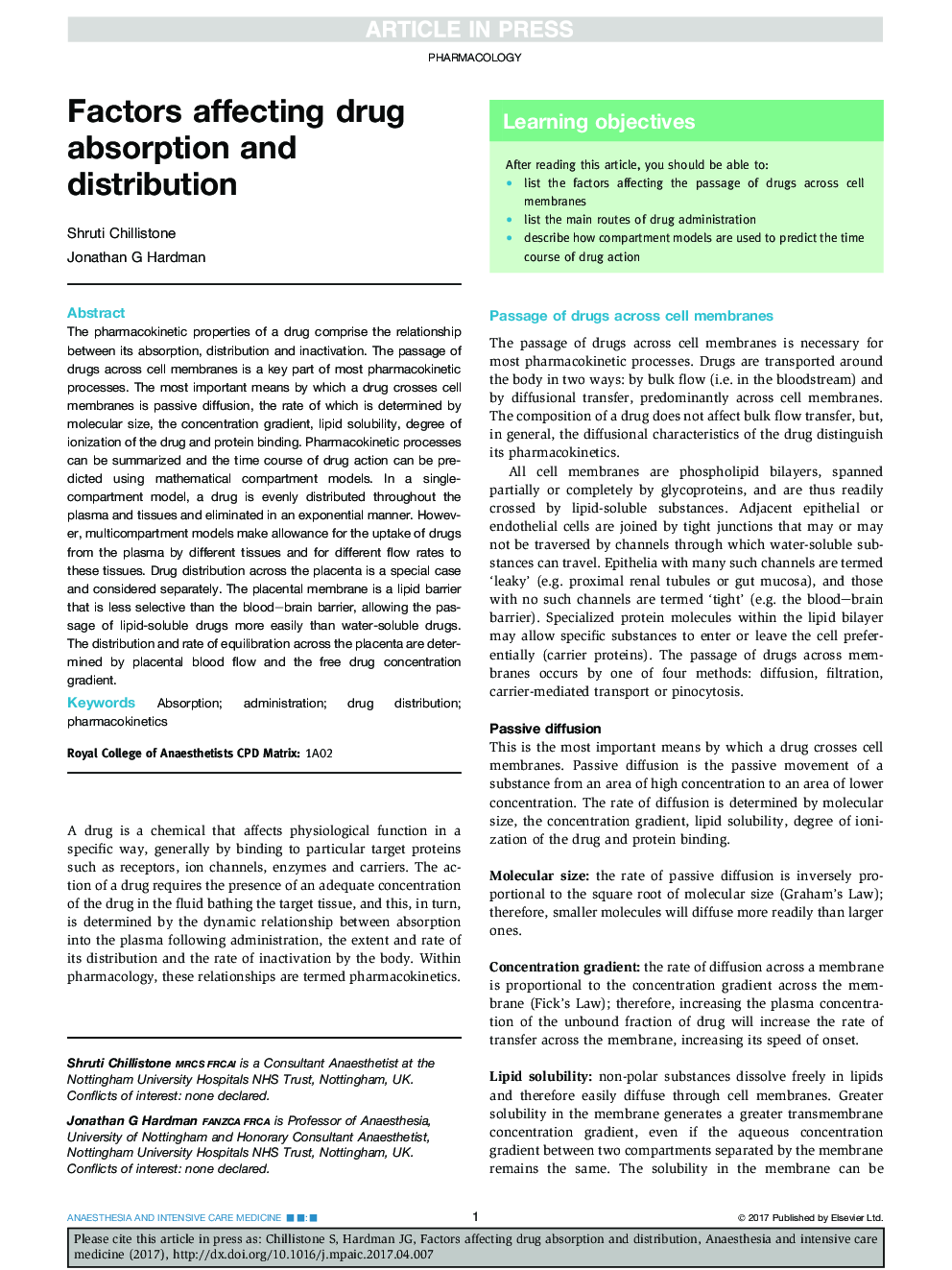| کد مقاله | کد نشریه | سال انتشار | مقاله انگلیسی | نسخه تمام متن |
|---|---|---|---|---|
| 5580174 | 1404148 | 2017 | 5 صفحه PDF | دانلود رایگان |
عنوان انگلیسی مقاله ISI
Factors affecting drug absorption and distribution
ترجمه فارسی عنوان
عوامل موثر بر جذب و توزیع دارو
دانلود مقاله + سفارش ترجمه
دانلود مقاله ISI انگلیسی
رایگان برای ایرانیان
کلمات کلیدی
جذب، مدیریت، توزیع دارو، فارماکوکینتیک،
ترجمه چکیده
خواص فارماکوکینتیک یک داروی شامل رابطه بین جذب، توزیع و غیر فعال شدن آن است. انتقال مواد مخدر در سراسر غشاء سلولی، بخش مهمی از بیشتر فرآیندهای فارماکوکینتیک است. مهمترین وسیله ای که دارو از طریق غشای سلولی عبور می کند، انتشار پوسیدگی است که میزان آن به وسیله اندازه مولکولی، گرادیان غلظت، حلالیت لیپیدها، درجه یوناسیون دارو و اتصال پروتئین تعیین می شود. فرآیندهای فارماکوکینتیک را می توان خلاصه کرد و مدت زمان اقدامات دارویی را می توان با استفاده از مدل های محفظه ریاضی پیش بینی کرد. در یک مدل مجزا، یک داروی به طور مساوی در پلاسما و بافت توزیع می شود و به شیوه ای غریب حذف می شود. با این حال، مدل های چندگانه برای دریافت مواد مخدر از پلاسما با استفاده از بافت های مختلف و برای جریان های مختلف به این بافت ها کمک می کند. توزیع دارو در جفت یک مورد خاص است و جداگانه در نظر گرفته شده است. غشای جفتی یک مانع چربی است که کمتر از سلول های مغزی مغزی انتخاب می کند و اجازه می دهد تا داروهای محلول در چربی راحت تر از داروهای محلول در آب باشد. توزیع و میزان تعادل در جفت توسط جریان خون جفتی و گرادینت غلظت دارو آزاد تعیین می شود.
موضوعات مرتبط
علوم پزشکی و سلامت
پزشکی و دندانپزشکی
بیهوشی و پزشکی درد
چکیده انگلیسی
The pharmacokinetic properties of a drug comprise the relationship between its absorption, distribution and inactivation. The passage of drugs across cell membranes is a key part of most pharmacokinetic processes. The most important means by which a drug crosses cell membranes is passive diffusion, the rate of which is determined by molecular size, the concentration gradient, lipid solubility, degree of ionization of the drug and protein binding. Pharmacokinetic processes can be summarized and the time course of drug action can be predicted using mathematical compartment models. In a single-compartment model, a drug is evenly distributed throughout the plasma and tissues and eliminated in an exponential manner. However, multicompartment models make allowance for the uptake of drugs from the plasma by different tissues and for different flow rates to these tissues. Drug distribution across the placenta is a special case and considered separately. The placental membrane is a lipid barrier that is less selective than the blood-brain barrier, allowing the passage of lipid-soluble drugs more easily than water-soluble drugs. The distribution and rate of equilibration across the placenta are determined by placental blood flow and the free drug concentration gradient.
ناشر
Database: Elsevier - ScienceDirect (ساینس دایرکت)
Journal: Anaesthesia & Intensive Care Medicine - Volume 18, Issue 7, July 2017, Pages 335-339
Journal: Anaesthesia & Intensive Care Medicine - Volume 18, Issue 7, July 2017, Pages 335-339
نویسندگان
Shruti Chillistone, Jonathan G. Hardman,
